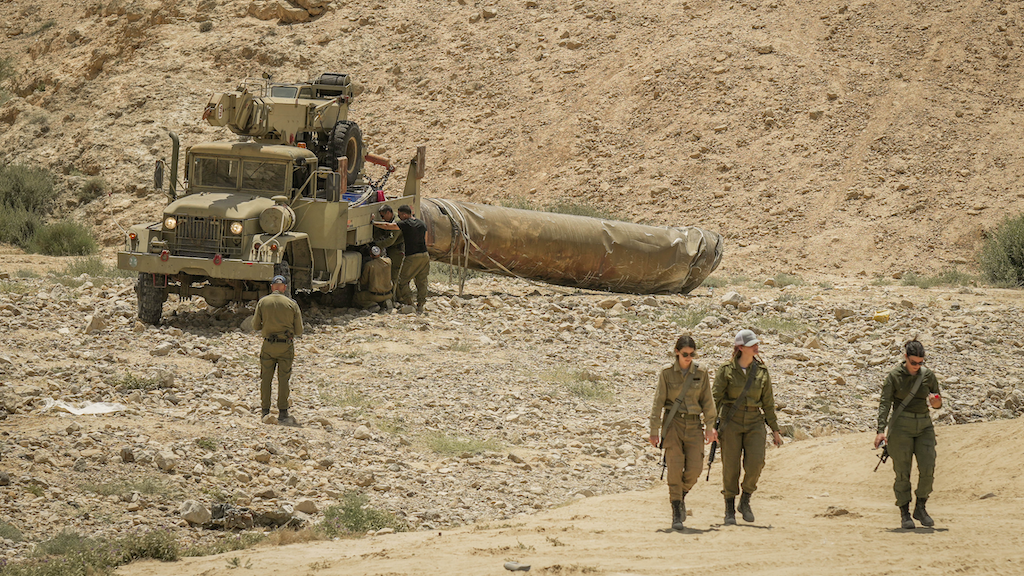Iran and the Multi-Front War Against Israel
The multi-front war against Israel that started with the Hamas pogrom in southern Israel on 7 October 2023, is now more than seven months old. There appears to be no end in sight as Israel must change the equation in the war against the so-called Iranian resistance axis.
In April, the war escalated to such an extent that a direct confrontation between Israel and Iran could no longer be ruled out.
That was after the Israeli Air Force on 1 April killed seven top commanders of the Iranian Revolutionary Guards who were meeting in a building next to the Iranian consulate in Damascus.
Among the slain IRGC commanders was Mohammad Reza Zahedi, the commander of the Quds Force in Syria, and his deputy, General Hadi Haj Rahimi.
That liquidation in Syria, the 18th since December 2023, was too much for Iran, which vowed to take revenge and, through its leader Ayatollah Ali Khamenei, announced that Israel would be “punished”.
Iran’s response finally came on the night of 13-14 April when more than 300 unmanned kamikaze aircraft, cruise missiles, and ballistic missiles were fired at Israel.
Ultimately, 99 per cent of those projectiles were shot down inside and outside Israel by a coalition secretly formed in 2022 by US General Frank McKenzie supplemented by Jordan’s air force to the surprise of many. More about Jordan’s motivations for its surprising intervention later.
Israel responded in the early hours of Friday, 19 April, when a radar-invisible hypersonic missile struck the air defences of the Natanz nuclear reprocessing plant near the city of Isfahan.
The Israeli government originally decided to carry out a major retaliatory attack on a series of selected targets in Iran, but this was abandoned under American pressure as President Joe Biden’s administration did not want to risk being drawn into a regional war.
The purpose and how the attack was carried out (from Iraqi airspace) sent a clear signal to the regime in Tehran: Israel was able to hit Iran’s nuclear facilities without Iranian air defences detecting it.
The escalation was over, and Iran, as well as Israel, appear to have returned to what the IDF refers to as the “MABAM doctrine”, the ‘war between the wars’ that characterised the battle between the two archenemies for years.
Iran, meanwhile, is working hard on its imperialist plans for the Middle East and the world and is trying to expand its influence into Africa.
Defence ties with Sudan were recently strengthened, with Iran selling scores of attack drones to the country at the Red Sea. Relationship with Niger has also greatly improved.
The latter is related to Iran’s nuclear programme because Niger has large reserves of yellowcake, a substance used for uranium production.
However, Iran also continues to try to expand its imperialist programme in the Middle East. In this context, there are fears in Israel that Iran will attempt to bring neighbouring Jordan under its sphere of influence.
Iran already uses Jordan as a smuggling route for weapons and ammunition to the various terrorist groups in Judea and Samaria, the heartland of Israel. However, there are signs that Iran may want Shiite militias now stationed in Syria to infiltrate Jordan.
This is a nightmare scenario for Israel but also for the Hashemite regime of King Abdullah II.
For this reason, the presence of IDF troops in the Jordan Valley has already been increased, and increased attention is being paid to arms smuggling to Judea and Samaria.
Iran already uses Jordan as a smuggling route for weapons and ammunition to the various terrorist groups in Judea and Samaria, the heartland of Israel.
At the same time, Jordan previously carried out unprecedented air strikes on smugglers in southern Syria.
The situation on the so-called heartland front has recently reached worrying proportions as Iran has managed to convert the cities of Tulkarm and Jenin in Samaria into forward IRGC bases.
Islamic Jihad, which is fully funded and armed by Iran, has made Jenin its headquarters and has complete control over what happens in the city.
The IDF, for its part, has long been on an offensive to frustrate the build-up of the terror infrastructure in Judea and Samaria with raids carried out daily in Palestinian towns and villages, usually resulting in long firefights with the terrorists, who are increasingly better equipped with Iranian help.
In Iraq, meanwhile, Iran is trying to use its proxy umbrella organisation, the Islamic Resistance of Iraq (IRI), to eliminate the US military presence in both Syria and Iraq.
After a short break, almost daily drone and missile attacks on the US bases in the two countries by IRI were resumed on 22 April. The US response to this aggression has been minimal, encouraging Iran to continue its attacks.
IRI is also directly involved in the fight against Israel and regularly attempts to carry out drone attacks on targets in the Jewish state but has so far been unsuccessful.
Then there is the front with the Ansar Allah or Houthi militia in Yemen, which has become a major problem for international maritime shipping in both the Red Sea and the Indian Ocean.
Ansar Allah (The Helpers of Allah) operates as a full- fledged division of the IRGC and has highly sophisticated weapons with which the militia has carried out nearly 60 attacks on ships it says have ties to Israel since November 2023.
Ansar Allah has also sabotaged fibre communications cables in the waters off the coast of Yemen and disrupted internet traffic in Africa.
At the beginning of May, Ansar Allah leader Abdul- Malik al-Houthi announced that his militia would now also attack Israeli shipping in the Mediterranean. For the time being, however, it is unclear how Ansar Allah would be able to execute these attacks, given the distance from Yemen to the Mediterranean Sea.
Finally, there is another worrying development concerning Iran. According to Rafael Grossi, the director of the International Atomic Energy Agency IAEA, Iran is now just two weeks away from achieving breakout capability in its nuclear programme.
The Islamic Republic now has enough highly enriched uranium to produce five nuclear warheads for its ballistic missiles, experts say.
Grossi had previously reported that IAEA inspectors had lost track of developments in Iran’s nuclear programme. At the same time, senior IRGC officials indicated, after the escalation with Israel, that Iran could now start to produce atomic weapons.
This now is the state of affairs in Iran’s asymmetric war against Israel and the United States.






